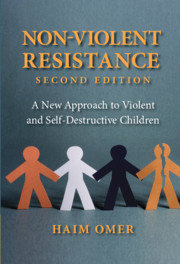Book contents
- Non-Violent Resistance
- Non-Violent Resistance
- Copyright page
- Dedication
- Contents
- Introduction to the New Edition: The Development of NVR
- 1 Principles and Goals
- 2 Escalation Processes
- 3 The Parents’ Instruction Manual
- 4 NVR in Action
- 5 Violence toward Siblings
- 6 Controlling and Seclusive Children
- 7 Schools
- 8 NVR in the Community
- Afterword
- References
- Index
2 - Escalation Processes
Published online by Cambridge University Press: 05 May 2021
- Non-Violent Resistance
- Non-Violent Resistance
- Copyright page
- Dedication
- Contents
- Introduction to the New Edition: The Development of NVR
- 1 Principles and Goals
- 2 Escalation Processes
- 3 The Parents’ Instruction Manual
- 4 NVR in Action
- 5 Violence toward Siblings
- 6 Controlling and Seclusive Children
- 7 Schools
- 8 NVR in the Community
- Afterword
- References
- Index
Summary
An understanding of escalation processes is crucial to any confrontation with violence. Escalation processes, as we saw in Chapter 1, are of two kinds: reciprocal and complementary. In parent–child relations, these two types of escalation intensify each other, and an ongoing swing between giving in and hitting out has been shown to be a common characteristic of families with violent and self-destructive children (Bugental et al., 1989; Dishion et al., 2016). In this chapter, we attempt to trace the processes that fuel these two types of escalation and suggest possible ways of averting them.
- Type
- Chapter
- Information
- Non-Violent ResistanceA New Approach to Violent and Self-Destructive Children, pp. 68 - 85Publisher: Cambridge University PressPrint publication year: 2021

